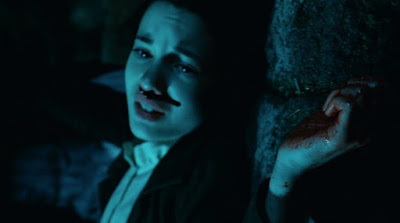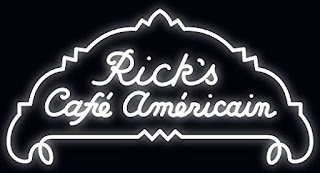(Personal) Short Film Evaluative Analysis (including 3 selected short-films, that collectively total at 80+ minutes).
For the assigned ‘Film Studies’ project, we were tasked with
the creation of a 5-minute short film that conveyed a sufficient understanding
of standard film form, camera usage, script writing, necessary planning (prior
to the final shooting of the film,) & basic acting skills. I decided, as
one who possesses an interest in practical effects (, VFX) and science-fiction,
monster movies from the ’80s to late ’90s, that I would create a short film
that made use of my (already existing) artistic skill set. When first
conceptualising the film’s plot and general style, I began to integrate visual
& film based elements from a small referential collection of films &
media that I had personally selected; these included titles such as, ‘The Thing
(1982)’, ‘Evil Dead 2’ & ‘An American Werewolf In London’. It is from these
sources of reference that I finally established my main film concept (along
with some creative concepts contributed by my father who works within the film
industry). The film was quickly given the name of ‘Man’s Best Friend’ as a
direct form of dramatic irony since the film itself is presented as a
student-horror production featuring my own dog as the antagonist. This was done
in an attempt to create a deeper connection between the film itself and my own
personal life & existence at home (with my family); I desired not to
produce a 5-minute short that possessed no substantial, tangible connection to
the one(s) who created it.
Since I wanted my short-film to be a student-horror that
made efficient use of practical effects, stop-motion animation & my own pet
dog, I chose to use the movie, ‘The Thing (1982)’ as my primary source of
referential material & inspiration for this creative facet of the project.
Upon having taken an interest in the somewhat morbid yet fantastical &
bizarre physical props & models featured within the movie, I began to
accumulate the required knowledge and materials/mediums to produce something of
that standard on my own. Although it took a great deal of time longer than I
would have originally suspected and or desired to create the finalised prop, I
believe its quality is of a sufficient calibre to be used as a homage to 1982
classic as well as the man behind it, the now-retired special-effects artist,
‘Rob Bottin’. While the overall animation process of the finished prop has
proved to be somewhat difficult due to slight structural faults and
inconsistencies within the animated footage, I find that in its overall
creation I have become enamoured with the creative process and have gained a
new found respect for the artistic minds behind the previously mentioned
titles.
The film’s plot is relatively simple as it was designed to
be a compact narrative that would rely strongly on the delivery of the
animation and use of practical effects (over any actual character development
& critical dialogue). In short, I intended to take a creature as loveable
as a dog, a species best known for its associated themes of loyalty,
companionship & empathy, and simply turned into something that subverted
all of these assigned traits. Though the film’s title does suggest quite
clearly that the dog will be the primary focal point of the film, I should hope
that the twist ending I have adopted into the narrative should prove to catch
some individuals off guard (during their first viewing of it). During the
constructive process of ‘Man’s Best Friend’, I was somewhat (creatively)
influenced by the fourth-wall breaking, short film, ‘The Gunfighter’. Featured
within this 9-minute long, western narrative is a number of intriguing plot
based mechanics that not only helped to drive the quick & quirky story but
also (somewhat) differentiate it from other titles featured within similar settings
& genres. Unlike my own short film, ‘The Gunfighter’ makes considerable
usage of (somewhat phallic) comedic elements to emphasise flaws within
19th-century society as well as stereotypical sexual concepts & themes that
still exist within our current, 21st-century society. The short itself features
a varying cast of (occasionally romanticised) western stereotypes conversing
amongst one another whilst gradually becoming more irritable & irrational
due to the intervention of a (somewhat) fantastical & malevolent,
intangible narrator that can actively speak to all those featured within the
narrative whilst also possessing a level of omniscience that allows him/it to
draw upon character flaws & previously unknown information to further drive
the narrative forwards. While this method of storytelling is effective at
forcing character development as well as simply conveying a ‘character’ within
a limited length of time; relying upon it too heavily for anything longer than
a short film would (ironically) create a narratively weak story-line. In
regards to the overall aesthetic of ‘The Gunfighter’, the western (themed)
saloon that serves as the primary setting for the film serves as a fine
contribution to the genre as the interior possesses a dulled colour-scheme that
primarily features hues of a dark brown to tanned variety. The beams of light
that manage to invade the inside of the saloon, forcing the shadows into the
corners and innermost sanctums of the bar, emphasise just how engorged the air
is with dust & other minuscule forms of debris; this truly helps to capture
that western (stereotypical) environment that we have all been exposed to
through a variety of written & visual media. However while the overall
visual elements are well suited to the western genre, they do work against the
narrative in a visual sense since they simply become monotonous to look at over
an extended period of time. Having ultimately enjoyed my initial viewing of
‘The Gunfighter’, I found myself partially captivated with its implementation of
an (arguably) twist-ending; as an individual I have always shown an interest in
this narrative technique as it can be used to completely subvert concrete
elements of a plot/story and ultimately create an ending that allows for the
greater application of creative ideas. As one might suspect I have adopted a
twist-ending into the plot of ‘Man’s Best Friend’ as I believe it allows for
(a) sudden change relative to the brief context of the 5-minute short film.
When creating ‘Man’s Best Friend’, I desired to have the big
monster reveal at the end to convey a deep, personal love for early
science-fiction, monster movies whilst also possessing a semblance of my own
artistic integrity (& infatuation with works born of true innovative
passion). That is why, upon my most recent viewing of (Wallace & Gromit’s,)
‘The Wrong Trousers’ I have been influenced enough, to try my hand at
stop-motion animation (, an art form I have not attempted in years,) in an
effort to create something that I can pride myself on, long after its
completion. The (30-minute long,) short film, ‘The Wrong Trouser’ is an
animated production brought to us by the inspiring minds working at ‘Aardman
Studios’ during the late ‘90s. The short itself possesses a narrative that
draws greatly from British themes & stereotypical elements, including but
not limited to, constructed settings, (contextually relevant) mannerisms &
characters; though the overall plot is nothing entirely new, it serves as a
humble, visually appealing & entertaining example of what a group can
achieve with plasticine & an idea. Each of the characters featured within
the film have been designed in such a way that one might be able to immediately
grasp the kind of personality they have been assigned without any prior
information, take Wallace for example, his standard attire resembles that of a
humble, British male; the implementation of a woollen (sleeveless) jumper
suggests that he prefers to live a comfortable lifestyle and his small but
exaggerated red tie conveys latent qualities of formality. In addition to this,
his smile/mouth is broad and kind, this immediately implies that he is a
simple, empathetic man whose physical appearance actively contrasts elements of
hostility & general negativity. It is this concept of constructive character
design that greatly inspired me to create my own character/creature whose
physical appearance/properties/characteristics immediately conveyed elements
stereotypically featured in genres such as horror, science-fiction and
thriller. It was with this sudden revelation of creative freedom that I decided
to dive head first into the creative process with the full intent to imbue my
design with a sense of character that best suited the narrative I was
constructing at the time. That is why, much like Wallace’s exaggerated smile,
my design was given physical characteristics/qualities that emphasised the
cinematic context that inspired its conception.
Upon my first viewing of the 39-minute short film,
‘Elephant’, (directed by Alan Clarke,) I found myself bored beyond reason by
the formulaic sequence of gunfights that trivialised all aspects of conflict
within the seemingly non-existent narrative. The film presents itself as a
visual commentary on the IRA and the violent acts it spurred amongst
(primarily) male groups. Most of the instances presented are completely devoid
of dialogue and leave one to wonder what is being gained within the context of
the scene; though each sub-narrative is presented in a manner that is realistic
and well-choreographed, the overall short-film feels as though it is
intentionally lacking any real sense of structure or form. Ultimately I
interpreted ‘Elephant’ as being a callous demonstration of (gun) violence
within society that dehumanises both the attacker and victim(s), almost conveying
them as mindless props within a setting that instils feelings of emptiness
within the audience due to the overwhelming lack of ‘life’ which we can
empathise with. This focus on constructing instances/settings that serve to
bolster the overall effect of the (conceptual) narrative is why I chose to film
my short horror film in an intentionally dark & naturally disturbing
environment. By putting greater focus on how the setting made me feel as a
viewer, (rather than an auteur,) I began to visually realise a narrative that
effectively coincided with visual themes and elements that were being passively
conveyed to those that viewed it.



Comments
Post a Comment